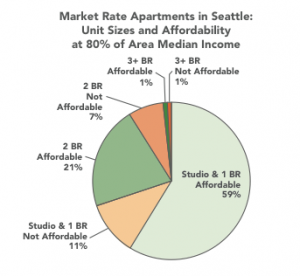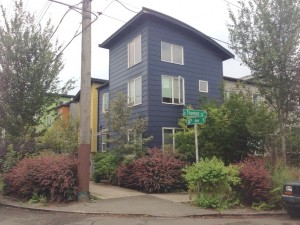More Family Housing: Change Values, Change Zoning
Earlier this year the Seattle Planning Commission released a Family Sized Housing Action Agenda calling for renewed efforts to create affordably priced housing for families in the City. Just recently A-P Hurd pointed out at the Atlantic’s City Lab blog that there are two regulatory hurdles that, when taken together, almost ensure that larger housing for families won’t get built affordably in the city: parking requirements and density and typology limits in single-family neighborhoods.
The typical assumption about the problem starts out on the wrong foot, considering the relative price and quantity of affordable two and three bedroom apartments.
 The Planning Commission starts out this way too in its white paper, pointing out the scarcity of larger apartments.
The Planning Commission starts out this way too in its white paper, pointing out the scarcity of larger apartments.
As of 2009, just 2 percent of market-rate apartment units in Seattle have 3 or more bedrooms, and half of that tiny fraction are affordable to low- income families.
The Commission’s review seems to write off the detached single-family typology as more or less out of reach.
Detached single-family, duplex, and triplex rentals are an important, but limited source of family-sized housing affordable to low and middle-income families.
But the same thing is true currently of apartments. Why is it that the commission and most of us tend to think the large family issue will be resolved in the multifamily type of housing rather than single family? The assumption is largely based on an inversion of our perception of the value of multifamily and single-family property.
Ask almost anyone not in the real estate business and ask her whether her property would be worth more zoned single-family or multifamily. Most people would answer that the higher value is in single-family. That’s an indicator of social values, not economic ones.
Hurd points out in her post that a typology called perimeter housing has great promise to create housing for family. The type is common in Europe and houses many families in dense urban envrionments. Perimeter housing is
Row-houses are built continuously around a central courtyard. The kitchens and living spaces are on the ground floor facing the courtyard, allowing a free flow of children and parents between the indoor and outdoor spaces. The cost of perimeter block housing is very competitive with apartments and often less expensive than townhouses.
Obviously requiring parking for these kinds of projects would add lots of costs. For most of us in the world of real estate and housing that’s a given and it’s why smart growth advocates push for no parking minimums; parking might be something worth building if customers want to buy it, but it always adds costs to housing.
But Hurd makes another important point. Because the perimeter housing idea is always implemented in multifamily zones, the land is much more expensive. There are two great examples in Seattle, one older and one newer that use the idea of a central courtyard and are built in one of city’s densest neighborhood, Capitol Hill.
In practice, this means that two or three story, small-footprint perimeter block housing can only be built in zones where four or five or six story apartment buildings are also allowed. Given a certain cost for the land, it will always be more profitable to build to the maximum height and density in these zones, thereby making perimeter block housing the least profitable option.
There are a couple of examples of housing that approaches the perimeter model in one of Seattle’s densest neighborhoods Capitol Hill.
Here’s Broadway Court, an older building,

and the newer Secret Garden, by the Madrona Company.
Secret Garden isn’t rental housing but was built as condos. But the point is there are examples, however few, of the typology we could aim for. But how would we motivate the market to produce more housing like this?
Allowing perimeter block housing within single family zones, where it would be the most profitable form in that zone, would result in much more of it being built.
Lower land costs in single-family zones could make these projects, but it would require a major paradigm shift in thinking among policy makers that would allow more innovation in the single-family space. Too bad that lately we’ve seen the opposite approach, making it harder to build in single-family.
How Would We Stop Growth Anyway?
One of the more common complaints I hear when I work on various volunteer efforts I’m a part of, or following local news, is that Seattle is growing too much and too fast; too many people moving here, the growth is unsustainable; the cost of living is out of control from so many high-paid new employees (e.g. Amazon) and a litany of other related things. Without getting into whether or not these views are accurate or the goals are good or bad, how could you really legally stop growth under our Federal, state, county or city laws?
Say the “anti-growth people” or “restricted growth people,” broadly defined, actually got a majority of the City Council and the Mayor’s office in an election:
- How could you actually limit the ability of businesses to move to Seattle?
- How could you actually limit the ability of businesses to add more employees to Seattle locations?
- How could you actually limit the ability of Seattle businesses to pay higher wages to employees, to keep the cost of living from escalating?
- How could you stop builders from building when zoning is already in place and many, many projects are already green lit legally?
- How do you stop the cost of real estate and rentals from rising? Note: Rent control is illegal under state law and no one but extremely fringe political thinking says this will change any time soon.
- How could you simply stop new people from moving here?
If 1-6 aren’t your goals — they seem to be, based on the constant complaints — what are the explicit end-game goals and how would you actually enact their achievement?
Any answers have to be compliant with the Constitution, Federal law, and state law. I’m genuinely curious as to what solutions are proposed to these ends, which are not pie-in-the-sky improbable or illegal. What remedies exist to reach the desired ends?
Even if you’re not in favor of these things, weigh in — how COULD they legally be done? I’m at a loss of figuring some of them out.
Joe Szilagyi is a West Seattle resident, and volunteer with the Westwood-Roxhill Arbor Heights Community Council and the West Seattle Transportation Coalition.
Study: Renters! There Goes the Neighborhood?
On Saturday morning I took part in a discussion of microhousing on a panel convened as part of the regular monthly meeting of the Seattle Neighborhood Coalition. Even though the discussion was announced with a lengthy and biased history of microhousing in Seattle by opponent Rick Barrett claiming that a “cabal” was “targeting” neighborhoods and avoiding the public process (Right. What does Barrett et al call what we’ve been doing over the last two years?), it was actually very well facilitated. There was only one moment when pandemonium broke out. I called the use of the term “renters” as code language intended to associate renters with all kinds of bad things in neighborhoods.
The exchange started when a woman in the front table started asking about “what kinds of people live in these small units without a bathroom.” I pointed out that nobody is building micro or congregate housing without bathrooms. I also pointed out that our own data show that the average tenancy in microhousing is about a year. I think she said “that’s not enough.” And she kept on asking about the people who are renters who aren’t invested in the neighborhood. She talked about the rental housing that was run down in the neighborhood. I countered that renters aren’t usually responsible for the upkeep of the buildings they live in. Then, after the sustained exchange, I suggested that talking about renters is code language intended to imply that renters are bad people.
That was the moment the room went a bit crazy. One man was shouting and banging his fists on the table. Another man, the camera man (the whole thing was video taped!), said, “you’re twisting the truth! Tell the truth.” It went on like that for awhile, a bit like one of those moments disorder that breaks out on the floor of the House of Commons. The facilitator, Bill Bradburd, actually did stand up and call everyone back to order, and we finished on a quieter note. But why the outrage and calling out the connection with “renters” with neighborhood blight? What does calling this out create such a stir?
Keep in mind what microhousing opponents have already said in public over the last two years in a seemingly endless process of disparaging developers and residents of microhousing. It has been documented at Publicola by Erica Barnett (more than once), Dominic Holden at The Stranger (also more than once), and in a very funny post called “The Ten Wackiest Comments by Seattle Microhousing Opponents.” And of course I’ve called out the angry neighbor comments here too, also more than once.
Here’s what Leroy Laney, an angry neighbor in Capitol Hill said to City Councilmember Sally Clark:
Are you spending time in the community to witness the increases in height allowances are disproportionate to the look and feel of entire blocks. Our lovely community is losing the appeal, charm and attraction for steady income, responsible, professional homeowners all for the ugly box and transient renter.
But the NIMBYs hate to be called out for this kind of speech that associates being a renter with neighborhood destruction. But if you don’t believe all the documentation about the vile stuff that comes out of the “established neighborhood” from us locals, there is a study that validates the phenomenon of using renters as the scapegoat for all kinds of awful things. A study by sociologist Kathy Kremer at Aquinas College in the Michigan Sociological Review, called, Homeowners, Renters, and Neighbors:Perceptions of Identity in a Changing Neighborhood takes a close look at how neighbors view renters. Kremer found that,
• 44 percent of the Creston residents [the neighborhood studied] indicated rental housing or renting households are their greatest neighborhood concern.
• Among only the home owners, 62 percent noted this was their greatest concern.
• Survey responses given by homeowners often connected rental units or renters themselves with other community concerns, such as crime or drugs.
Kremer goes on to point out that,
This data reflects the primary concerns of home owning residents of the Creston neighborhood, and their fear that this changing identity will lead to lower property values, drugs, and crime. Renters have also expressed concerns with renting households, but related to repairs needed and inattentive landlords.
All of this sounds familiar to anyone who has been following the microhousing debate. Change, by definition, is not easy because it involves the unknown. It makes perfect sense that people would be worried about new people moving into their neighborhood. But associating renters with things that would ruin the neighborhood isn’t fair. As my panel colleague Dennis Saxman and microhousing opponent pointed out, he has been criticized just because he’s a renter. Well, I am a renter too. And the study points out, renters do care about their buildings and how they work. Renters are impacted by the same problems as homeowners. Calling out the demonization of renters isn’t pleasant, but it isn’t pleasant listening to it either.
Our Response to Proposed Housing Strategy Committee
August 6, 2014
Dear Councilmember Clark,
Thank you for proposing a resolution to create a Comprehensive Housing Strategy Advisory Committee. We think this is a step in the right direction since we have called for the City Council to develop a comprehensive housing plan[1]. Attached you will the find the names of the many people who signed our petition.
They want a comprehensive plan using an array of tools to create housing for people at all levels of income in our city and coming to our city in future years. For it to comprehensive, any strategy must address more than just “affordable housing,” a problematic term (see below). Has the Council discussed this committee effort with the Mayor’s office or does this take the place of his committee?
We’ve also attached our Ideas for Change: Seattle’s Housing Future, a document that catalogs the many ideas for how we can improve housing availability, choice, and price in our city.
We have some specific thoughts about the resolution.
What does “affordable” mean?
First, and probably most important, we urge you to review current literature and best practice on the definition of affordable housing[2]. The history of the term will show you that the idea that housing is affordable when a household spends 30 percent of less of its income on housing is entirely arbitrary, starting as a 19th century prescription of “one weeks wages” per month for housing and then being changed in the early 1980s to 30 percent.
We need a better measure of what we mean by “affordable,” and until we come up with one, we should be careful how we use the term. That word, affordable, is a qualitative measure that is about a household or person’s relationship to price. All housing is affordable to someone.
Notwithstanding the iron clad HUD standard, what does the City of Seattle see as a prescriptive, normative standard for measuring when a person needs help with housing or other residual costs of living[3]. Seattle could lead the country in proposing a new baseline measurement of what we mean when we say, “affordable housing.[4]”
Remove the assumptions about need.
The resolution should remove all quantitative assumptions about where there is “the greatest need for assistance.” We have found that data from King County and the City do not support the statement that there is scarcity in the housing market for housing priced so a household earning 60 to 80 percent of Area Median Income (AMI). On the contrary, today, the market is doing pretty well producing housing at that price
The problem appears to be a scarcity of housing for households at lower levels of income, 50, 40, 30 percent and lower of AMI[5]. By putting this assumption in the resolution you will have already created a fundamental disagreement between stakeholders and validated a gross misreading of housing need in the City. Instead, please make the current measure of affordability and identifying the greatest need, a topic for the Committee to discuss and examine using all available data.
Many existing policies are working, especially MFTE[6]
We disagree with the implications of lines 17 through 23 that “existing policies are unlikely to provide the number of affordable units that will be required.” We oppose this language because, first, we need to decide what we think affordable is, and second, some of the programs like the Multifamily Tax Exemption (MFTE) actually can work very effectively; but this program has come under sustained attack as a giveaway. It is a giveaway: to renters who get lower rents.
Please complete a plan before imposing more rules, fees, and taxes on housing.
Lastly, we would ask that you and Councilmember O’Brien take no action on adjusting the Incentive Zoning fee, changing the code as it affects microhousing, and changing design standards in the city’s low-rise zones until the work of the Committee is done. It simply makes no sense to make decisions that remove options, or lock in specific approaches to the challenges we face accommodating growth, before the Committee has a chance to tackle housing issues. If the Council is genuine in its desire to come up with a plan, it ought to really plan, not try to change a bike tire while still riding the bike.
Of utmost importance, also, is inclusion of builders and developers of all housing types (i.e. single-family, multifamily, microhousing, mid and highrise) and building managers and landlords on the Committee.
Thank you for asking us to be part of this and we look forward to having representation on the committee and being an active participant in its work. We would welcome an opportunity to discuss the proposal further with you.
Sincerely,
Roger Valdez
[1] Smart Growth Seattle. Petition: More Housing Now
[2] There are at least two alternative measures for housing affordability. One is a residual income model that considers all of a households expenses taken together, then determines whether there is enough left over to cover housing costs. If a household can’t pay housing costs they may need a housing subsidy; or they might need a subsidy for day care. This measure better and more comprehensively considers the costs of living in the City. Similarly, the Center for Neighborhood Technology has developed a measure that accounts for the reduced transportation costs of living in the city.
[3] Seattle’s own Diana Pierce, a professor at the University of Washington, has been a leader in exploding the categories of how we measure poverty and affordability. She has created a self-sufficiency measure that should be part of this discussion.
[4] For a brief history of the 30 percent “rule of thumb,” see, Who Can Afford To Live in a Home?: A look at data from the 2006 American Community Survey, Mary Schwartz and Ellen Wilson; US Census Bureau.
[5] Housing and Community Development Needs Assessment (Appendix A), see especially pages 70 and following.
[6] “As of the end of 2013, OH had approved MFTE applications for projects comprising 4,369 affordable for-rent units and 108 affordable for-sale units, for a total of 4,477 affordable units,” City of Seattle Multifamily Property Tax Exemption Program 2013 Status Report to City Council – April 21, 2014, page 3.
More Housing Now Petition
Seattle is a growing city. In fact, Seattle was the fastest growing major city in the nation last year. And Seattle’s prosperous job market, along with our city’s cultural and natural amenities, is expected to bring another 120,000 residents and 115,000 jobs over the next 20 years. If we do not adequately accommodate this growth, Seattle will be much less affordable than it is even today and only the most affluent will be able to live in the city.
The City of Seattle needs a housing plan to ensure that the city is encouraging enough housing to be built to accommodate current and future demand. An inadequate supply of housing in the city makes housing much more expensive and displaces working class households to suburbs – placing additional stress on our already burdened transportation infrastructure and increasing sprawl.
While we appreciate that the Seattle City Council has attempted to address affordable housing, it has focused too much of its efforts on housing policies that have produced very few affordable units and actually decrease the availability of housing and increase the cost of most new housing through per square foot fees, zoning and other regulatory restrictions. In this case, good intentions have produced unintended consequences.
Taxing new housing to pay for new housing is not working. Making housing more expensive is not making it more affordable. In addition to the development of a citywide housing plan, we encourage the Seattle City Council to seriously consider strategies that other cities have used to success, such as:
- Utilize publicly-owned land for the provision of affordable housing;
- Establish a fund to acquire, or to encourage preservation of, older housing stock for affordable housing;
- Review and consider changes to zoning and land use regulations to ensure that the City is encouraging an adequate supply of housing to accommodate future growth; and
- Eliminate or reduce City policies that limit housing availability and add to the cost of new housing.
Rather than continuing to rely on policies that have clearly not improved Seattle’s affordability (and may have contributed to the problem), we ask that you try more effective approaches and adequately plan for the future. Read more about ideas and tools that can help in our Ideas for Change: Seattle’s Housing Future.
Signed by,
1 A-P Hurd
2 Aaron Buxbaum
3 Aaron Laing
4 Abdullazize Alhammad
5 Adam Brown
6 Adam Peterson
7 Adrien Renaud
8 Al Clark
9 Albert Clark
10 Alessandra Allen
11 Alex Ratner
12 Alex Tiburcio
13 Alexander Broner
14 Amy Towillis
15 Andrew Donaldson
16 Andrew Hunt
17 Andrew Parise
18 Angela Kahler
19 Ann Chamberlin
20 Ann Schuessler
21 Anthony Maschmedt
22 Anton Babadjanov
23 Augustus Bukowski
24 Barb Wilson
25 Barry Margolese
26 Barry Swanson
27 Bassam Jurdi
28 Beau Granger
29 Ben Frost
30 Bill Hinkle
31 Bill Nyland
32 Bob Dedon
33 Brad Easton
34 Brad Kilcup
35 Brandon Ellis
36 Brett Youngstrom
37 Brian Robinson
38 Brittany Granger
39 Bryan Loe
40 Byron Oxford
41 Cal McAllister
42 Canuche Terranella
43 Carol Houston
44 Carrie Dedon
45 Cary Lynn Johnson
46 Casey Schuchart
47 Celine Swanson
48 Chad duncan
49 Charles Spaeth
50 Chris Bajuk
51 Chris Faulkner
52 Chris Rossman
53 Christopher T Benis
54 CJ Bowles
55 Coriann Presser
56 Dan Chhan
57 Dan Duffus
58 Dan Mundle
59 Dan Wick
60 Darrin Granger
61 dave Biddle
62 David Perlmutter
63 Derrick Codomo
64 Diane Undi-Haga
65 Donald Baptiste
66 Donald Marcy
67 Doug Branson
68 Dustin Van Wyck
69 Dylan Simon
70 edgar escandar
71 erich armbruster
72 Erik Ekstrom
73 Erwin Park
74 glenn amster
75 Gloria Arteaga
76 Greg Nelson
77 Greg Smith
78 Hubert Ellwein
79 Hugh Brannon
80 Ian Strader
81 Ila Dickenson
82 Isaac Patterson
83 Jack Rader
84 Jake Seliger
85 James Coombes
86 James Kahler
87 James Parker
88 James r Johnson
89 Jamin Glenn-Harrison
90 Janine Namgung
91 Jeff Curwen
92 Jeff Henderson
93 Jen Clement
94 Jennifer Daly
95 Jennifer Hackett
96 Jerrid Anderson
97 Jill McCormick
98 Jim Sykes
99 Joanne Lee
100 John Carter Woollen
101 John D Cowan
102 John S. Teutsch
103 Jon Coombes
104 jon hudson
105 Jonathan Winslow
106 Jonathon Morrison Winters
107 Julia K-P
108 Julie Merritt
109 Kabi Gishuru
110 Kara Boden
111 Karl Krispin
112 Katie Higgins
113 Keith Hammer
114 Kelly Foster
115 Kirk Gronvold
116 Kristin Jensen
117 Ksenya Lagutina
118 Laura Sullivan
119 Lin Gale
120 Linda Pruitt
121 Lisa Long
122 LP Nitkey
123 Macenzie Hadley
124 maggie capelle
125 Malcolm E. Jolly
126 Marc Rudd
127 Marjan Foruzani
128 Mark Dibble
129 Mark Haizlip
130 Mark Jackson
131 Mary Kathleen Dedon
132 Matt Gangemi
133 Meredith Everist
134 Mia Marshall
135 Michael Ravenscroft
136 Monica Smith
137 Nancy Bainbridge Rogers
138 natalie gualy
139 Nathan Jones
140 Nicholas Draney
141 Nicholas Lee
142 Nick Etheredge
143 Nicole Hernandez
144 Norma Jean Hanson
145 P Scott Cummins
146 Paige Nilsen
147 Patrick Cobb
148 Patrick J Kassin
149 Patrick J Kassin
150 Paul LaBellarte
151 Paul Mendes
152 Paul Poirier
153 Pearl Leung
154 Peter Leahy
155 Randall Olsen
156 Randall Spaan
157 Rich Wagner, FAIA
158 Rob Harrison AIA
159 Rob Stephenson
160 Roger Valdez
161 Ron Day
162 Ryan Fitzgibbon
163 Scott Anderson
164 Scott Dolfay
165 Scott E. Shapiro
166 Scott Erickson
167 Scott Jeffries
168 Scott Matthews
169 Scott McDonald
170 Scott Ulrich
171 Scott Whaley
172 Severin Hagen-Lillevik
173 Sharon Coleman
174 Sloan Ritchie
175 steele granger
176 Steele Johnson
177 Stephen Martineau
178 Steve Gough
179 Stuart Hand
180 Susan Stasik
181 Thomas Frye, Jr. AIA
182 Thomas L Reid
183 Tina Pappas
184 Todd Smith
185 Tony Pai
186 Tony Spinrad
187 Tony Stewart
188 Tracy Ann Michel
189 Ty Bennion
190 Tyler Abbott
191 Tyler Anderson
192 Tyler Smith
193 Veronica de Saram
194 Victor J. Meyer
195 Wende Miller
196 William R. Bannecker
197 Williams Jarvis
198 Winnie Lam
199 Zach Nostdal
200 Zachary Goodwin
City Council: Can’t Find a House? Move to Oklahoma!
We nicknamed our video “they’re making it worse” for a reason. When Seattle City Council fails to do the right thing, good people move to….Oklahoma! The City has already lost a basketball team to the Sooner State, but now we’re losing real people who can’t find a place to live. Here’s a passage from a recent story in the Seattle Times about someone who had to leave Seattle because he couldn’t find a place to live:
“Everything is here; everything is coming here,” said Aasim Saleh, 30, who moved from Seattle to coach kayaking in the Boathouse District, where construction of a new whitewater center is planned for this fall.
Saleh moved because he had an opportunity to make about $60,000 a year while avoiding a desk job. The low cost of living was a major sweetener, he said, enabling him to become something he thought would not be possible: a homeowner.
“I would say that, 100 percent, I had given up on the idea of homeownership in Seattle,” he said. “Which is a really big deal.”
Remember Councilmember Tim Burgess’s dismissive tone about how the loss of 250 new buildable lots in Seattle wasn’t “meaningful?” And how about Councilmember Tom Rasmussen’s amendment to downzone single-family home building by lowering heights and complicating the code? Then there is Councilmember Sally Bagshaw’s comments about wanting notice and appeal for every new single-family home in Seattle, a recipe for scarcity and increased costs. Don’t forget Representative Gerry Pollet and his colleague Gael Tarleton who were trying to change state law on behalf of angry neighbors opposed to new single-family homes. Ask people trying to buy a single-family home in Seattle what they think about the efforts of these Councilmembers and legislators to pander to the status quo crowd.
In another Seattle Times story from over the weekend, you can read about the bidding wars erupting in Seattle because of the scarcity of single-family homes.
In Seattle’s Ravenna neighborhood, a renovated home on a large lot offered at $549,500 drew about 20 bids and sold in May for $687,000, or 25 percent over the list price. While that’s an extreme case, about two-thirds of Ravenna homes sold this spring went for above list price.
And how does Seattle compare to other large cities?
In the second quarter, the Seattle metro’s housing market ranked sixth nationally for the share of homes sold above list, behind only five metros in and around the San Francisco Bay Area, according to data from Seattle-based real-estate brokerage Redfin.
Expensive, right? Well it’s no wonder when the Council seems to be doing everything it can to eliminate single-family options because, ironically, they think single-family is expensive and not affordable housing. But many, many people want to own a home. If supply is constrained with more rules, prices will go up and stay up, making a fortune for the people behind One Home Per Lot, the lobbying group that wants to sue and appeal every new single-family home in Seattle. All of the new rules and limits are great if you own a house now; your asset increases in value and price. Meanwhile people like Saleh leave town, or are forced into bidding wars over scarce single family homes.
The worst move the Council made was voting against the 100 percent rule, a compromise that would have allowed 250 new, scaled, and right sized homes in the city. The number of additional lots seem small, but as I pointed out would make a big impact on the economy of the city. It may not meaningful to Burgess and the Council, but to people packing their bags for other places, like Oklahoma, additional homes on the market would have meant more choice and a chance to own.
I would hope the City Council would fight just as hard when it comes to losing people to Oklahoma as they did to keep a basketball team.










